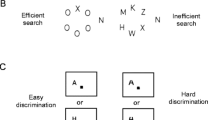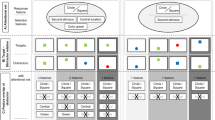Abstract
The biased-competition theory of attention proposes that objects compete for cortical representation in a mutually inhibitory network; competition is biased in favor of the attended item. Here we test two predictions derived from the biased-competition theory. First we assessed whether increasing an object’s relative brightness (luminance contrast) biased competition in favor of (i.e., prioritized) the brighter object. Second we assessed whether increasing an object’s size biased competition in favor of the larger object. In fulfillment of these aims we used an attentional capture paradigm to test whether a featural singleton (an item unique with respect to a feature such as size or brightness) can impact attentional priority even when those features are irrelevant to finding the target. The results support the prediction that a singleton with respect to luminance contrast receives attentional prioritization and extend the biased-competition account to include size contrast, because a large singleton also receives attentional prioritization.


Similar content being viewed by others
References
Bacon, W.F., & Egeth, H.E. (1994). Overriding stimulus-driven attentional capture. Perception and Psychophysics, 55, 485–496.
Braun, J. (1994). Visual search among items of different salience: removal of visual attention mimics a lesion in extrastriate area V4. The Journal of Neuroscience, 14, 554–567.
Bundesen, C. (1990). A theory of visual attention. Psychological Review, 97, 523–547.
Chun, M. M., & Marois, R. (2002). The dark side of visual attention. Current Opinion in Neurobiology, 12, 184–189.
Chun, M. M., & Wolfe, J. M. (1996). Just say no: how are visual searches terminated when there is no target present? Cognitive Psychology, 30, 39–78.
Desimone, R., & Duncan, J. (1995). Neural mechanisms of selective visual attention. Annual Review of Neuroscience, 18, 193–222.
Duncan, J., & Humphreys, G. W. (1989). Visual search and stimulus similarity. Psychological Review, 96, 433–458.
Folk, C. L., & Annett, S. (1994). Do locally defined feature discontinuities capture attention? Perception and Psychophysics, 56, 277–287.
Folk, C. L., Remington, R. W., & Johnston, J. C. (1992). Involuntary covert orienting is contingent on attentional control settings. Journal of Experimental Psychology: Human Perception and Performance, 18, 1030–1044.
Folk, C. L., Remington, R. W., & Johnston, J. C. (1993). Contingent attentional capture: a reply to Yantis. Journal of Experimental Psychology: Human Perception and Performance, 19, 682–685.
Franconeri, S. L., & Simons, D. J. (2003). Moving and looming stimuli capture attention. Perception and Psychophysics, 65, 999–1010.
Green, B. F., & Anderson, L. K. (1956). Color coding in a visual-search task. Journal of Experimental Psychology, 51, 19–24.
Itti, L., & Koch, C. (2000). A saliency-based search mechanism for overt and covert shifts of visual attention. Vision Research, 40, 1489–1506.
Jonides, J., & Mack, R. (1984). On the cost and benefit of cost and benefit. Psychological Bulletin, 96, 29–44.
Jonides, J., & Yantis, S. (1988). Uniqueness of abrupt visual onset in capturing attention. Perception and Psychophysics, 43, 346–354.
Kastner, S., Nothdurft, H-C., & Pigarev, I. N. (1997). Neuronal correlates of pop-out in cat striate cortex. Vision Research, 37, 371–376.
Maunsell, J. H. R., & McAdams, C. J. (2000). Effects of attention on neuronal response properties in visual cerebral cortex. In M. S. Gazzaniga (Ed.), The new cognitive neurosciences. Cambridge: MIT.
Moran, J., & Desimone, R. (1985). Selective attention gates visual processing in the extrastriate cortex. Science, 229, 782–784.
Mounts, J. R. W., & Tomaselli, R. G. (2005). Competition for representation is mediated by relative attentional salience. Acta Psychologica, 118, 261–275.
Parkhurst, D., Law, K., & Niebur, E. (2002). Modeling the role of salience in the allocation of overt visual attention. Vision Research, 42, 107–123.
Pashler, H., & Badgio, P. C. (1985). Visual attention and stimulus identification. Journal of Experimental Psychology: Human Perception and Performance, 11, 105–121.
Pashler, H., Dobkins, K., & Huang, L. (2004). Is contrast just another feature for visual selective attention? Vision Research, 44, 1403–1410.
Proulx, M. J., & Egeth, H. E. (in press). Target–nontarget similarity modulates stimulus-driven control in visual search. Psychonomic Bulletin and Review.
Reynolds, J. H., & Chelazzi, L. (2004). Attentional modulation of visual processing. Annual Reviews of Neuroscience, 27, 611–647.
Reynolds, J. H., & Desimone, R. (2003). Interacting roles of attention and visual salience in V4. Neuron, 37, 853–863.
Reynolds, J. H., Pasternak, T., & Desimone, R. (2000). Attention increases sensitivity of V4 neurons. Neuron, 26, 703–714.
Rossi, A. F., Rittenhouse, C. D., & Paradiso, M. A. (1996). The representation of brightness in primary visual cortex. Science, 273, 1104–1107.
Theeuwes, J. (1991). Cross-dimensional perceptual selectivity. Perception and Psychophysics, 50, 184–193.
Theeuwes, J. (1992). Perceptual selectivity for color and form. Perception and Psychophysics, 51, 599–606.
Todd, S., & Kramer, A. F. (1994). Attentional misguidance in visual search. Perception and Psychophysics, 56, 198–210.
Treisman, A. M., & Gormican, S. (1988). Feature analysis in early vision: evidence from search asymmetries. Psychological Review, 95, 15–48.
Turatto, M., & Galfano, G. (2000). Color, form and luminance capture attention in visual search. Vision Research, 40, 1639–1643.
Verghese, P. (2001). Visual search and attention: a signal detection approach. Neuron, 31, 523–535.
Wolfe, J. M. (1994). Guided Search 2.0: a revised model of visual search. Psychonomic Bulletin and Review, 1, 202–238.
Wolfe, J. M., Friedman-Hill, S. R., Stewart, M. I., & O’Connell, K. M. (1992). The role of categorization in visual search for orientation. Journal of Experimental Psychology: Human Perception and Performance, 18, 34–49.
Yantis, S. (1993). Stimulus-driven attentional capture and attentional control settings. Journal of Experimental Psychology: Human Perception and Performance, 19, 676–681.
Yantis, S., & Egeth, H. E. (1999). On the distinction between visual salience and stimulus-driven attentional capture. Journal of Experimental Psychology: Human Perception and Performance, 25, 661–676.
Yantis S., & Jonides, J. (1984). Abrupt visual onsets and selective attention: evidence from visual search. Journal of Experimental Psychology: Human Perception and Performance, 10, 601–621.
van Zoest, W., & Donk, M. (2004). Bottom-up and top-down control in visual search. Perception, 33, 927–937.
Acknowledgments
This material is based upon work supported under a National Science Foundation Graduate Research Fellowship to M.J. Proulx and grants from the Binational Science Foundation and the Transportation Security Administration to H.E. Egeth. Portions of this research were reported at the annual meeting of the Vision Sciences Society, Sarasota, Florida, May 2002. We thank Steven Yantis and Sarah Shomstein for technical assistance, John Serences for helpful discussions, and Bruce Bridgeman, Asher Cohen, and Peter Frensch for insightful comments on a previous version of this manuscript. M.J. Proulx is now at the Institute of Experimental Psychology II, Heinrich Heine University Düsseldorf.
Author information
Authors and Affiliations
Corresponding author
Rights and permissions
About this article
Cite this article
Proulx, M.J., Egeth, H.E. Biased competition and visual search: the role of luminance and size contrast. Psychological Research 72, 106–113 (2008). https://doi.org/10.1007/s00426-006-0077-z
Received:
Accepted:
Published:
Issue Date:
DOI: https://doi.org/10.1007/s00426-006-0077-z




